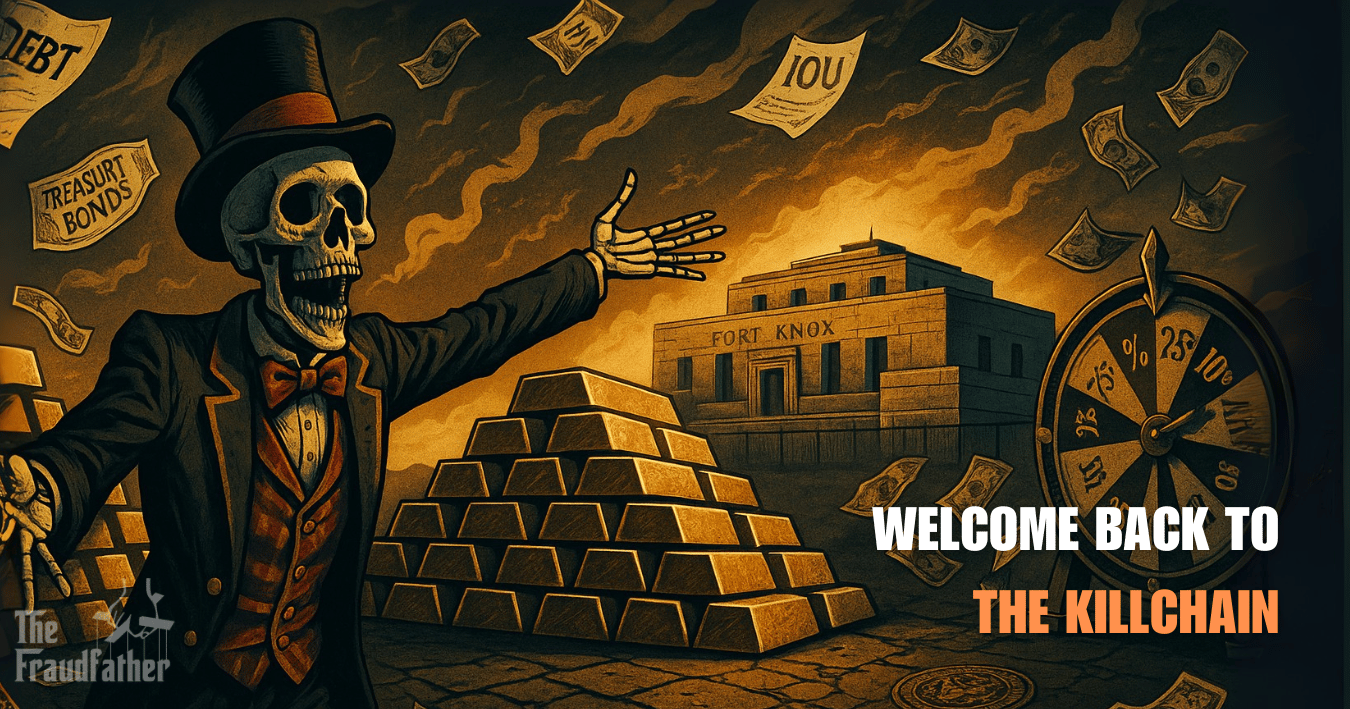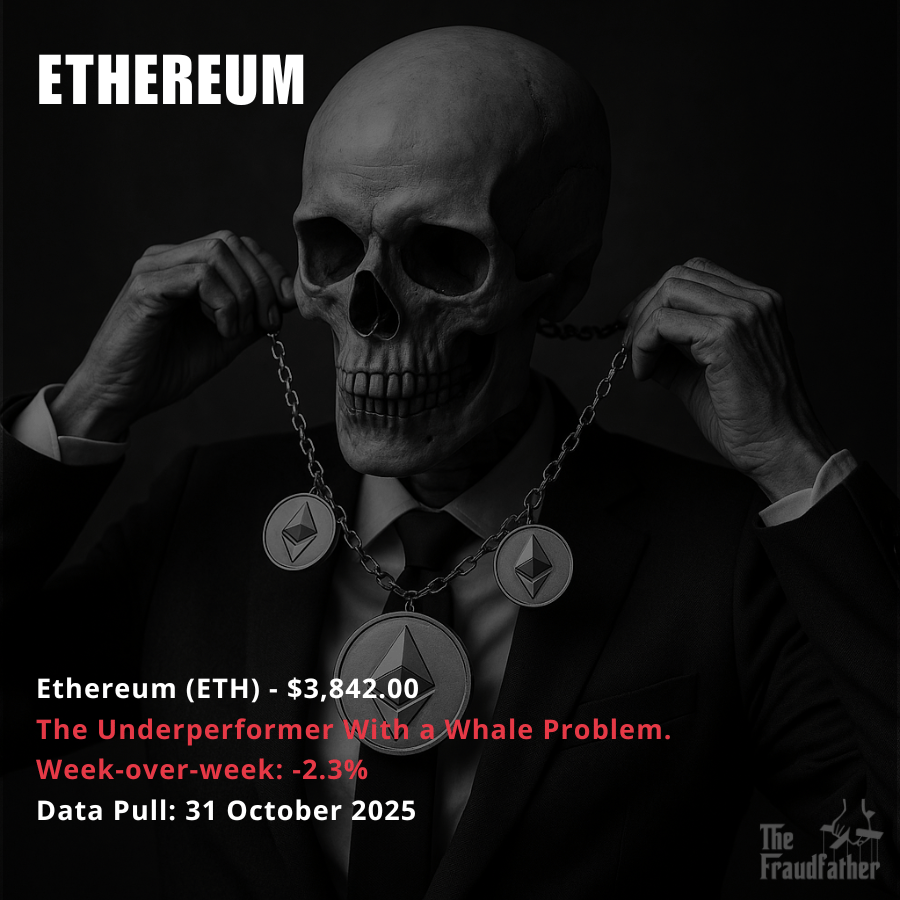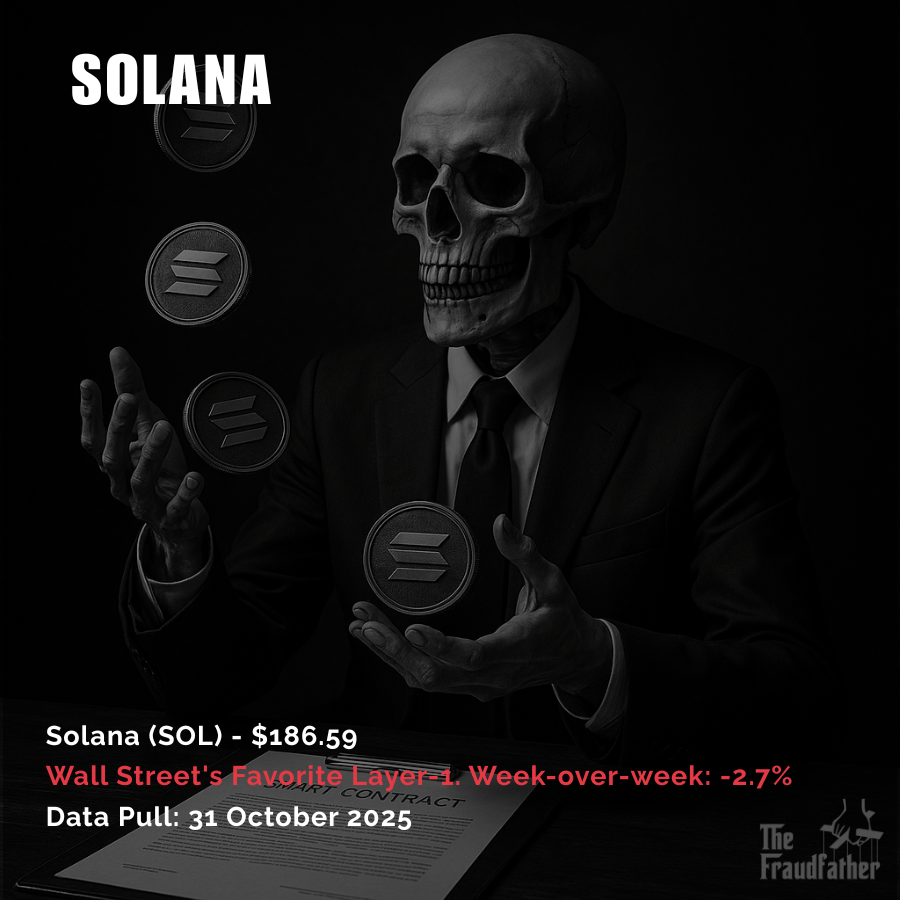- The KillChain
- Posts
- $864 Million Bought a Pardon. One Year Bought Your Trust.
$864 Million Bought a Pardon. One Year Bought Your Trust.
Trump's crypto empire extracted $864M in six months. North Korea spent a year building a fake identity to infiltrate DeFi. Meanwhile, BTC defended $108K as institutions accumulated through retail panic. This week: the corruption that's visible and the espionage that isn't.



In September 2025, Binance hired lobbyist Charles McDowell, a friend of Donald Trump Jr., paying $450,000 for one month's work lobbying the White House for "executive relief." On October 23, Trump pardoned Zhao.
How to Buy a Presidential Pardon for $2 Billion
Last week we told you about Trump's pardon of Changpeng Zhao, the Binance founder who pleaded guilty to enabling money laundering. We showed you the timeline: the lobbying payments, the $2 billion MGX investment using Trump's stablecoin, the pardon days later.
This week, new reporting from the Wall Street Journal and Reuters reveals exactly how deep the corruption runs and how much money the Trump family extracted.
What We Learned This Week
According to the Wall Street Journal, after Trump won the 2024 election, Binance created a "high-level task force to strike a deal" with World Liberty Financial, the Trump family's cryptocurrency venture, and launched a months-long bid for clemency.
But Binance didn't just use the Trump family's stablecoin. They built it. Binance wrote the basic code to power World Liberty's USD1 stablecoin and promoted the coin to its 280 million users around the globe. World Liberty's stablecoin shares jumped from $127 million to over $2.1 billion this spring after Binance stepped in.
Then came the $2 billion MGX deal. In May 2025, MGX, a state-controlled Abu Dhabi investment company chaired by the UAE's national security adviser, used USD1 to invest $2 billion in Zhao's company. That $2 billion is held in U.S. Treasury securities generating about $80 million annually in interest payments. Some of those payments flow to World Liberty affiliates, including one 38%-owned by the Trump Organization.
In September 2025, Binance hired lobbyist Charles McDowell, a friend of Donald Trump Jr., paying $450,000 for one month's work lobbying the White House for "executive relief."
On October 23, Trump pardoned Zhao.
Six days later, on October 29, Binance US announced the listing of World Liberty Financial tokens. WLFI surged over 20% following the pardon.
The $864 Million
Here's what makes this week's reporting critical: we now know how much cash the Trump family extracted.
According to Reuters calculations based on presidential disclosures, property records, financial records, and crypto trade data, the Trump Organization's income soared 17-fold in the first half of 2025, jumping from $51 million to $864 million. Of that total, $802 million, more than 90%, came from Trump crypto ventures.
The Trump family made $463 million from sales of World Liberty tokens alone. They made $336 million from sales of the $TRUMP meme coin. Traditional Trump businesses generated $33 million from golf clubs and resorts and $23 million from real estate licensing.
That $864 million represents actual cash flowing into Trump family coffers. On World Liberty's website, a Trump Organization entity receives 75% of the revenue from token sales. Members of the Trump family, through an umbrella company, own more than half of World Liberty.
The Foreign Roadshow
After Trump's election victory, Eric Trump and Donald Trump Jr. embarked on a globetrotting investment roadshow across Europe, the Middle East, and Asia. Days before Trump's second inauguration, the Trump Organization released revised ethical guidelines that eliminated the prohibition on seeking new foreign business that had existed during his first term.
In a review of the 50 wallets holding the largest amounts of World Liberty tokens, crypto analytics firm Nansen found that 36 wallets, with holdings valued at $804 million, were likely connected to overseas buyers.
Reuters interviewed half a dozen foreign crypto entrepreneurs who met with the Trump brothers. Five of them said they sought out the younger Trumps because of their proximity to the president and hopes of cashing in on his political and financial power.
Dubai, May 1, 2025
Eric Trump was meeting with Chinese businessman Guren "Bobby" Zhou and his associates on the sidelines of a cryptocurrency conference. Eric pitched buying at least $20 million in World Liberty tokens, according to a person familiar with the meeting.
Zhou had been arrested in Britain in 2021 under suspicion of money laundering and remains under investigation by Britain's National Crime Agency. In three separate civil cases between 2017 and 2023, Chinese courts found Zhou and a family member failed to repay loans totaling $2.4 million.
On June 26, an entity called Aqua1 Foundation announced it was buying $100 million in World Liberty tokens. About a month after Zhou met with Eric Trump, Web3Port's BVI entities, where Zhou had served as chairman, changed their names to "Aqua1," according to local government records.
On June 30, Zhou appeared on a livestream from the UAE and said, "We're very proud to be a major player in the World Liberty, which is Trump's family's crypto venture."
Justin Sun: $75 Million and a Paused SEC Case
Among the largest buyers is Justin Sun, a Hong Kong-based crypto billionaire. The SEC in 2023 charged Sun with fraud and selling unregistered crypto securities. With Trump back in the White House, the commission paused the case in February, weeks after Sun announced he had increased his World Liberty token purchases to $75 million. Under World Liberty's distribution agreement, Sun's purchases sent $56 million to the Trump family.
The Assessment
Frank Bowman, a University of Missouri law professor who studies pardons: "If reporting on the financial ties is accurate, the pardon is perhaps the most overtly corrupt in American history. Zhao helps the Trumps make billions and gets a pardon."
World Liberty told the Wall Street Journal that a pardon was never discussed and the company "has never assisted in, facilitated, or influenced a decision on Mr. Zhao's presidential pardon." A lawyer for Binance said there was "no impropriety."
What Blockchain Actually Exposed
Last week we said blockchain didn't create this corruption. This week's reporting proves it. Presidential pardons have always been for sale. What changed is the visibility.
Binance built the Trump stablecoin. An Emirati sovereign fund used it to invest $2 billion in Binance. The Trump family collects interest. Binance hired Trump Jr.'s friend to lobby for clemency. Trump pardoned the money launderer. Binance listed Trump's tokens six days later.
Every transaction is documented. Every payment is traceable. The Trump family extracted $864 million in six months. The corruption is visible in real time on a public ledger.
That's crypto in 2025.
What This Means for the Market
Here's the tactical reality: corruption removes regulatory barriers faster than legislation ever could. The Justice Department axed its crypto enforcement team. The SEC paused or dropped lawsuits against crypto firms. Binance is preparing to re-enter the U.S. market after a 2023 ban. Bitcoin ETFs have absorbed 18% of circulating supply. Institutions are building positions.
Short-term, this is rocket fuel. Regulatory capture accelerates adoption. Capital flows to wherever enforcement disappears. The market doesn't care about ethics; it cares about obstacles being removed.
Long-term, this is structural risk. When an entire industry's growth depends on one family's political protection, you're not building an alternative financial system. You're building a patronage network. The second that protection evaporates, through scandal, impeachment, election, or term limits, every firm that bought access becomes a prosecution target.
The house always wins. Right now, the house is the Trump family. That's great for prices until it isn't. Watch what happens when the music stops.
Become the go-to AI expert in 30 days
AI keeps coming up at work, but you still don't get it?
That's exactly why 1M+ professionals working at Google, Meta, and OpenAI read Superhuman AI daily.
Here's what you get:
Daily AI news that matters for your career - Filtered from 1000s of sources so you know what affects your industry.
Step-by-step tutorials you can use immediately - Real prompts and workflows that solve actual business problems.
New AI tools tested and reviewed - We try everything to deliver tools that drive real results.
All in just 3 minutes a day

Battlefield Intelligence: What the Numbers Truly Reveal.
Evolution Check: Last week we called for breakouts above key resistance levels. The Fed had other plans. BTC touched $116K before Powell's hawkish tone triggered the largest weekly ETF outflows in months. But here's what matters: every support level we flagged held. Bitcoin defended $108K. Solana held $183. The structure didn't break, but rather recalibrated. That tells you this isn't distribution. It's consolidation under pressure.
Weekly ETF outflows hit $600 million, yet cumulative Bitcoin ETF inflows for October totaled $3.69 billion. The month ended with more capital in than out. The week-to-week noise doesn't change the month-over-month signal.
Watch your levels. BTC needs to reclaim $113,600. ETH needs $4,000 back. SOL needs $194. Get those, and November's historical tailwinds kick in. Lose them, and we retest lower supports, but the data says buyers are waiting there.
Now let's see where we actually stand.

BTC is consolidating just above the 200-EMA base around $108K, where dip-buyers stepped in twice during October. This is the line. Hold it, and November's historical median return of 11.2% makes it Bitcoin's second-best performing month. Lose it, and we're testing the short-term holder cost basis at $97,500.
Bitcoin: $109,538 | The Line Between Accumulation and Capitulation
Week-over-week: -1.6%
Bitcoin failed to clear $114,500 last week and instead gave us a masterclass in "sell the news" dynamics. The Fed cut rates 25bps on October 30 as expected, but Chairman Powell hinted it may be the last cut of 2025. Markets didn't like the hawkish tone. Over $80 billion was wiped off total crypto market cap in 24 hours as traders liquidated positions.
But look deeper. On-chain data from Binance showed over 10,000 BTC flowing to exchanges during the October 30 volatility spike, with nearly all of it from addresses that held coins less than 24 hours. That's hot money exiting, not conviction breaking. Weekly ETF outflows hit $600 million, yet Bitcoin ETFs recorded $149 million in net inflows on October 27, their third straight day of gains before the Fed meeting. Institutions accumulated into the event, then let retail panic while they repositioned.
BTC is consolidating just above the 200-EMA base around $108K, where dip-buyers stepped in twice during October. This is the line. Hold it, and November's historical median return of 11.2% makes it Bitcoin's second-best performing month. Lose it, and we're testing the short-term holder cost basis at $97,500.
The tactical setup: Trading above $113,600, the short-term holder cost basis, is now pivotal for confirming a constructive shift. This level has historically marked the transition from corrective to accumulation phases. A daily close above $112,900 (50 EMA) would re-ignite trend strength. From there, Bitcoin must clear resistance zones at $117,261 and $120,000 to target its all-time high of $126,199.
Key levels:
Support: $108K (critical), $106K (secondary)
Resistance: $113,600 (STH cost basis), $117K, $120K
Invalidation: Daily close below $106K
BlackRock's IBIT is now generating $244.5 million in annual revenue with assets approaching $100 billion. When the world's largest asset manager builds that much infrastructure around Bitcoin, temporary volatility becomes buying opportunity. The question isn't if Bitcoin recovers; it's whether you positioned when everyone else was panicking.

Ethereum failed to hold $4,000 and is now trading uncomfortably close to the $3,790 support level we flagged as critical. ETH has spent the past two weeks hovering around the $4,000 mark after stabilizing from the October 11 flash crash below $3,500. The structure is intact but deteriorating.
Ethereum: $3,842 | The Underperformer With a Whale Problem
Week-over-week: -2.3%
We told you to watch ETH ETF flows. You should have listened. Ethereum ETFs experienced $244 million in outflows this week, led by Fidelity's FETH with nearly $92.25 million. Not a single one of the nine ETH ETFs posted net inflows. This isn't rotation into better opportunities; this is capital fleeing to Bitcoin while the Fed uncertainty plays out.
Ethereum failed to hold $4,000 and is now trading uncomfortably close to the $3,790 support level we flagged as critical. ETH has spent the past two weeks hovering around the $4,000 mark after stabilizing from the October 11 flash crash below $3,500. The structure is intact but deteriorating.
Here's the contrarian signal: While ETFs bleed and retail sells, whales added 1.64 million ETH (roughly $6.4 billion) in October despite a 7% monthly price decline. Wallets holding between 1,000 and 100,000 ETH are accumulating through weakness. The Holder Accumulation Ratio dropped from 31.27% to 30.45%, showing long-term holders trimming while whales position. This divergence typically precedes major moves.
Ether futures are trading at only a 5% premium over spot prices, suggesting muted leveraged demand and cautious sentiment among traders. That's actually bullish. Overleveraged markets correct violently. Cautious markets build bases.
The technical picture: On the 2-day chart, ETH shows signs of hidden bullish divergence, price making higher lows while RSI makes lower lows, indicating sellers are losing strength. ETH must close above $4,300 to validate a breakout and confirm continuation of the long-term uptrend. A clean move above $4,240 could push ETH toward $4,620, the upper end of its long-term channel.
Key levels:
Support: $3,790 (must hold), $3,510 (invalidation)
Resistance: $4,000 (reclaim needed), $4,240, $4,300
Catalyst: Fusaka upgrade tentatively scheduled for November 2025, featuring PeerDAS to increase data blob capacity from 6 to 48 per block
Ethereum doesn't move on sentiment. It moves on technology delivering results. The upgrade pipeline is loaded. The whales are accumulating. The ETF bleeding will stop when institutions realize they're selling to smarter money at a discount.

Chart analysis suggests SOL may be at the start of a 5-wave Elliott Impulse sequence after successfully breaking above the descending trendline. Solana is trading above the 200-day EMA near $187, indicating steady accumulation. The RSI at 47.84 shows neutral momentum, sellers losing dominance, buyers quietly building strength.
Solana: $186.59 | Wall Street's Favorite Layer-1
Week-over-week: -2.7%
Solana dropped below our $190-192 consolidation zone and lost $197 support. But it held $183, the line we said would determine whether this is a dip or a breakdown. It held. That matters.
Now watch what happened while price fell: Bitwise's Solana ETF recorded $69.5 million in inflows on its first trading day, nearly six times the $12 million debut haul of its closest competitor. Grayscale's GSOL posted $1.4 million in net inflows. Total trading volume across both Solana ETFs hit $79.50 million in a single day.
Since early October, SOL has recorded more than $381 million in institutional inflows, exceeding the combined inflows of all other altcoins. While Bitcoin and Ethereum ETFs saw massive outflows this week, Solana ETFs are pulling capital. That's not correlation; that's conviction.
Chart analysis suggests SOL may be at the start of a 5-wave Elliott Impulse sequence after successfully breaking above the descending trendline. Solana is trading above the 200-day EMA near $187, indicating steady accumulation. The RSI at 47.84 shows neutral momentum, sellers losing dominance, buyers quietly building strength.
The setup: If SOL sustains above $190 support, current projections suggest reaching $205-$210 by early November. Key technical levels are $194 as immediate support and $295 as major resistance. Trading near current levels, SOL could surge past $213 toward $232 if bullish momentum holds.
Key levels:
Support: $183 (critical hold), $180 (invalidation)
Resistance: $194 (reclaim target), $200 (psychological), $213-$215
Breakout target: $232-$250
Why Solana matters now: When the October 10 liquidation event vaporized $19B in leveraged positions and crashed the market, Solana's network processed record DEX volumes without breaking a sweat while other chains buckled under load. Infrastructure that holds under maximum stress gets rewarded with institutional capital. That's exactly what's happening.
⚠️ The KillChain Disclaimer ⚠️
Informational & Educational Use Only
All content in this newsletter, including but not limited to market commentary, tactical read-outs, “buy-zone” language, and any linked training materials, is provided strictly for general, educational, and informational purposes. Nothing herein constitutes (or should be interpreted as) personalized investment, legal, accounting, or tax advice.
No Investment Recommendations
References to “accumulate,” “scale in,” “trim,” or similar calls to action are illustrative frameworks, not specific recommendations to buy, sell, or hold any digital asset, security, or derivative. You alone are responsible for evaluating the merits and risks associated with any use of the information provided before making any investment or trading decision. Consult a registered investment adviser or other qualified professional regarding your individual circumstances.

On March 26, 2025, Anton Bukov, co-founder of 1inch, exposed a shocking truth: the researcher who had generously shared his expertise was a fraud. Worse, he was a North Korean state-sponsored hacker.
The Year-Long Con: How North Korea Infiltrated Crypto's Security Elite
At the beginning of 2024, a blockchain security researcher named Nick L. Franklin quietly made his debut on Crypto Twitter. Armed with deep expertise in blockchain security, a relentless drive to make the crypto space safer, and a generous spirit that led him to support fellow security researchers and crypto builders, Nick quickly built a thriving community.
Over the past year, he freely engaged with co-founders of top DeFi protocols. He forged friendships with leading security researchers from prominent blockchain security firms. He shared his time, his security insights on exploits, and his advice on securing protocols. All of it, for free.
On March 26, 2025, Anton Bukov, co-founder of 1inch, exposed a shocking truth: the researcher who had generously shared his expertise was a fraud. Worse, he was a North Korean state-sponsored hacker.
The Unraveling
Bukov discovered that "Nick L. Franklin" had attempted to deliver malware to 1inch through what appeared to be a legitimate security collaboration. The attempted attack triggered an investigation that pulled apart Nick's entire constructed identity.
Security researcher Tanuki reviewed the GitHub repository compiled by MetaMask security researcher Taylor Monahan, which lists blockchain addresses linked to North Korean DPRK activities. One of the addresses had been used in testing for the $50 million Radiant Capital hack in October 2024, a hack attributed to the DPRK APT group AppleJeus, also known as Citrine Sleet and UNC4736.
The next day, security researcher pcaversaccio analyzed the malicious app file used in the attempted attack on 1inch. Based on his findings, he alleged the attack was "part of a broader deception and exploitation attempt and can be attributed with high confidence to the AppleJeus/Citrine Sleet DPRK team."
Nick L. Franklin, the helpful security researcher who had spent a year building trust and credibility in the crypto security community, was not one person. The pseudonym was a front for one or more AppleJeus agents who had constructed an elaborate, long-term social engineering operation.
The Scale of the Operation
This wasn't a quick phishing attempt or a rushed exploit. This was patient, methodical infiltration. Nick didn't just create a fake Twitter account and start posting. He demonstrated actual expertise. He helped people solve real problems. He invested months building genuine relationships with the people who build and secure billions of dollars in DeFi protocols.
The goal wasn't immediate theft. The goal was positioning. Get close enough to the right people, earn enough trust, and eventually you get access to the systems, code repositories, and private communications that matter. One successful malware delivery to the right target could compromise entire protocols.
Based on Nick's screening of past interactions documented by researchers, the operation had potentially positioned itself to target numerous high-value protocols beyond 1inch. The full scope of the infiltration remains unknown.
What This Means
AppleJeus is not a script kiddie operation. This is North Korea's premier cryptocurrency hacking unit. They've been linked to billions in stolen crypto over the years. They don't waste resources on low-probability schemes.
The fact that they invested a year building a fake security researcher identity tells you two things. First, they believe the long con works better than spray-and-pray phishing. Second, they're studying the crypto security community closely enough to understand what credibility looks like and how to fake it convincingly.
The crypto industry talks constantly about smart contract security, multi-sig wallets, and formal verification. This attack bypassed all of that. It targeted the humans who build the security systems. No amount of code auditing stops a trusted insider from clicking a malicious link or running a compromised app.
Nick L. Franklin's exposure was accidental. Bukov happened to catch the attempted malware delivery. How many other "Nick Franklins" are still operating, still building trust, still positioning themselves for the payload that hasn't been delivered yet?
The crypto security community just learned it's been playing chess against state-sponsored intelligence operatives who are willing to invest years in a single operation. The paranoia that follows is justified. Every helpful stranger, every generous researcher, every new voice offering free security advice now carries a question mark.
Trust is the vulnerability. North Korea found it. They exploited it. And they're still out there.
About the FraudFather:
The Fraudfather didn’t learn fraud from influencers or movies. He learned it chasing terrorists, flipping money launderers, and dismantling multi-million-dollar schemes, before most people knew what “DeFi” meant.
A former Senior Special Agent and Supervisory Intelligence Operations Officer, he spent over two decades tracking financial predators across borders, blockchains, and bureaucracies. From dark web forums to government war rooms, he’s seen every lie and loophole up close.
Now a “recovering” digital identity and cybersecurity executive, he’s turned his sights to teaching crypto, where old scams wear new skins, and smart contracts get played like slot machines.
Through The Fraudfather persona, he’s exposing how fraud really works on-chain:
How social engineers bypass wallet security
How cross-chain laundering pipelines stay hidden
How scammers weaponize human psychology faster than regulators can blink
This isn’t theory.
It’s operational intelligence, on-chain and in near real time.
Follow the Fraudfather and stay five moves ahead of the next exploit

